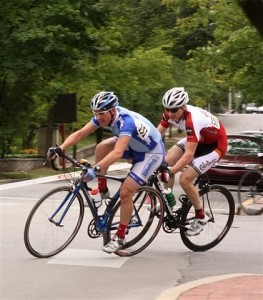In Washington, even exercise gets political.
This morning, the WSJ reported that a small group of Congressmen, primarily Republicans, have embraced the adrenaline-infused exercise regimen that is P90X. They jump, stretch and flex to the tune of Tony Horton, a man who clearly checked the right box on career day. The 90-day results-intensive program celebrates its “I couldn’t move the next day” sensations.
On the other side of the ideological spectrum resides the pragmatic approach of the White House. Last month, the NY Times described the regimented, non-boot-campish routine espoused by Mr and Mrs Obama. Our current executive branch favors a personal trainer who likes working people hard, but…”as politely as possible.” The president adheres to a common sense program of regular morning exercises that balances cardio and strength training. Calm, measured and balanced.
Both approaches to exercise appeal to me.
My Red Side:

The part of me that revels in aggressively racing around short circuits of closed city streets (for $50 payouts) sees the virtue of P90X. Criterium bike racing extols actions like attacking, jumping, and freight-training your opponents. It’s adrenaline worship on a grand-stage–the larger the crowd the better the sensations. Crit racing drains you, it hurts you, and like P90X, it’s rarely sustainable. But it sure feels good at the moment, and nothing makes a cold Coke (non-diet) taste better.
It’s undoubtedly true, on paper, the testimonials of those who commit to the P90X program are remarkable. And to his credit, Mr Horton strongly emphasizes the importance of combining sensible nutrition with daily exercises. He even promotes a less well-publicized maintenance P90X program. Good for him, and good for those individuals that springboard themselves to healthier lifestyles with the bouncy DVDs. Some people need a push to feel the glorious sensations of a thin, flexible and twitchy body.
My Blue Side:
The master-of-the-obvious doctor in me sees exercise that’s constantly intense and always so goal-oriented as troubling. Good health isn’t a race, nor is it achievable in 90-days. Sustainable health is about making daily exercise feel as normal as eating and drinking (or reading a blog). “Healthy” exercisers, like most vital 90 year-olds, dwell not on the final results of exercise, like looking good in a blue suit for the annual Lincoln Dinner, but rather the journey of a healthy life itself—exercise for the sake of exercise.
Shouldn’t exercise do more than just make us look better, or spend calories? In thirty minutes, I can easily burn more kilojoules pedaling my stationery bike trainer than I can tooling around our city parks. But when you ride—or run, or walk—outside, you actually go somewhere. Outdoors you might see a sunset, or a friend, or, you might even garner a new nickname when you note a “pretty flower” on the side of the road. (That’s how my teammate Erik got his nickname, “Flower.”)
I guess you could call me a centrist when it comes to exercise.
Though, I’d rather you call me a “crit-racer.”
JMM
2 replies on “CW: The Red and Blue of Exercise”
Hi Dr. John: Just found your blog and can’t stop reading. My husband had a heart attack at 46. Went into V tac during cardiac rehab and now has an ICD that paces him at 60 bpm. Before the pacemaker, his pulse would drop into the 30’s. Now periodically has AFIB and takes coumadin. Question is: when he is exercising, how can he determine his resting heart rate in order to compute the best range for exercising? He’s on day 14 of P90x. Doing plyometrics today, my max heart rate was 170 and his was only 140. He wants to do the best level of exercise for his heart and body, but don’t know how to compute it. Thanks!!
Thx Karen.
The low heart rate shouldn’t matter to your calculation.
Upper heart rates are very, very variable. How high one’s heart beats at a given energy output depends on many factors. I would guess that, for achieving physical fitness, 140 bpm is plenty high for a middle-aged man after a heart attack.
I encourage patients to correlate their level of perceived exertion with heart rate. On a scale of ten, with ten being the effort you would use to designate running from a loose tiger, and 1 being the effort you use walking out of an Italian restaurant, I would say that exercise in the 6-7 range provides a solid base. Short jabs into a higher perceived exertion level are also beneficial.
Maybe I should write a post about heart rates. The problem with writing so specifically about exercise prescriptions is that individuals vary so much. Offering specifics approaches coaching–and I am far from a coach.